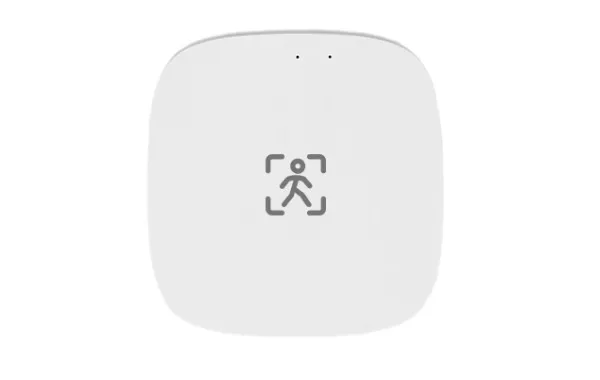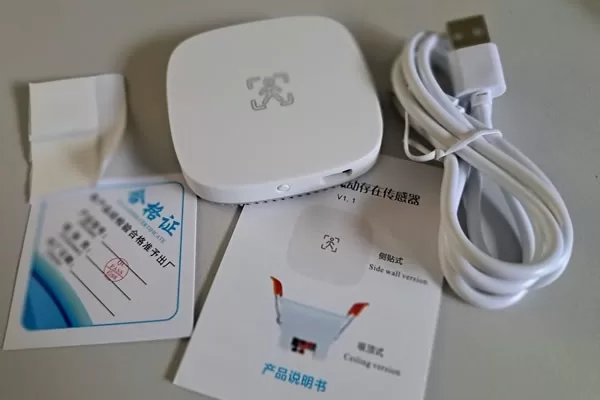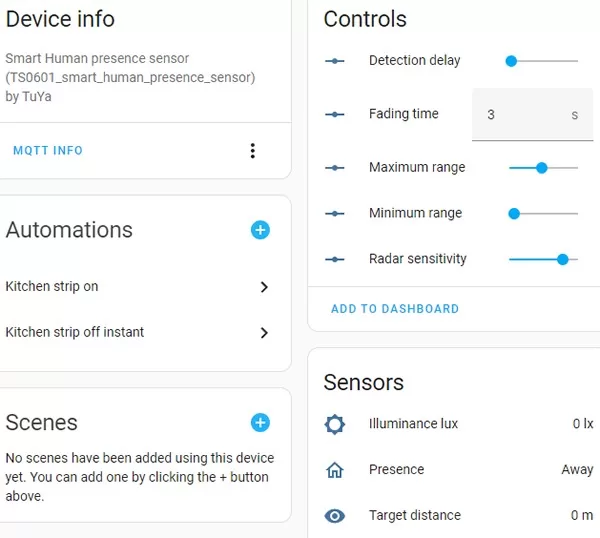
Not to be confused with PIR sensors, human presence sensors have been available for quite some time but have generally been priced out of reach of the average home user and have mostly been used is commercial settings. Recently, a flood of mmWave human presence sensors have become available at very reasonable prices, ranging from DIY boards for only a few dollars, up to more plug and play Wi-Fi and Zigbee solutions ranging up to the sub $100 mark. In this post I am going to look at a mid-range Zigbee mmWave sensor from Wenzhi / Tuya that I found on AliExpress known as the WZ-M100-W.
Pir vs mmWave
PIR (Passive Infrared) sensors and mmWave (millimetre wave) sensors are two types of technology commonly used for human presence detection. PIR sensors detect infrared radiation emitted by the human body, which changes as a person moves, and trigger an alert signal. They are relatively low cost and easy to install, but they can have limited range and sensitivity, and have limited adjustment. On the other hand, mmWave sensors use high-frequency radio waves to detect human presence and movement. They can have a much longer range, can detect through walls and can detect people sitting still, which makes them ideal for security and surveillance applications. Many mmWave sensors are also very configurable, which makes them ideal for tuning in your detection area.
Why mmWave
I currently have a few rooms in my house where the lights turn on when I enter the room, and they turn off when I enter a different room. Triggered by the PIRs on my alarm system it works flawlessly when there is only one person in the house and a bit flaky when there are two people in different rooms, I had managed to get around some of the issues with timers, but it still was not perfect, hence my want of a human presence sensor. So my plan now is in rooms that I have lights come on automatically, turn them on with my fast PIR sensors but don’t turn them off if there is someone in the room still.
Choosing a mmWave sensor
There are a few choices starting to reach the market now. The entry level is a DIY board under $10 that you could mate to an esp8266 or similar for a home brew solution. This is the path this YouTuber has taken with his presence sensor. If you are after a commercially manufactured device, Xiaomi was one of the early players on the scene with their FP1. An update to this device known as the FP2 has recently for around $84US been release and was out of stock when I went shopping.
What I went for is a Wenzhi / Tuya device known as the WZ-M100 which cost me under $36AU from AliExpress. Interestingly it comes in 2 different styles, one is a flush ceiling mount style (WZ-M100-C running off 80V to 240V) while the other is a small square puck style (WZ-M100-W running off 5v USB) that can be double side taped to a wall. Both versions come in either Wi-Fi or ZigBee communication standards. I went the 5V puck version in the ZigBee variety, as I am imaging the AC powered one would definitely not be approved for use in Australia and I prefer using Zigbee devices over Wi-Fi devices with crappy Chinese based apps.
Usage
I am using this sensor with Home Assistant via the ZigBee2MQTT integration. Being quite new on the market, it may not pair with all home automation platforms yet. In fact, it was not recognised out of the box with ZigBee2MQTT, but a quick search of the error found that people were already working on an external converter to support the device on GitHub that will be merged into the next realise of ZigBee2MQTT. Following the GitHub thread here, I was able to add it to my system. By the time you read this, it may be working with ZigBee2MQTT out of the box.
Pairing was straightforward and presented the controls and sensors you see below in Home Assistant. The maximum range is my favourite control as it allows me to set the distance of the room, so it won’t sense presence past the range of the door. A lux sensor is also included that you could use in your automations to determine if it is dark enough to turn the lights on or not. I am not using this feature, as I am in fact got the sensor behind a kitchen door. Unlike PIRs, mmWave sensors can work through doors and walls. Interestingly, despite the model name on the box and brand on the AliExpress site, the device reported itself to be a Tuya TS0601 smart human presence sensor once it was discovered by ZigBee2MQTT.
Another useful feature of the device is the fact that it is classed as a ZigBee repeater, giving it the ability to bolster your existing ZigBee network.
Final Thoughts
Long story short, I liked the WZ-M100 so much that I have ordered another one. Many people say mmWave senors may not be as fast as my PIR sensors to detect a person, but I have found it to be quite acceptable and about as fast as some Zigbee PIRs that I have previously tried.
I fortunately have my home alarm PIR sensors hooked up to Home Assistant and these operate lightning fast, so a combination of these two sensors to activate the lights and not turn them off if the room is still occupied suits me fine.
My only annoyance with this sensor is that it can detect motion from behind, so you will have to consider this when mounting this sensor in a room if you don’t want false positives from the adjacent room.
Resources
The included user manual
The sensor I purchased: https://www.aliexpress.com/item/1005004704966668.html

